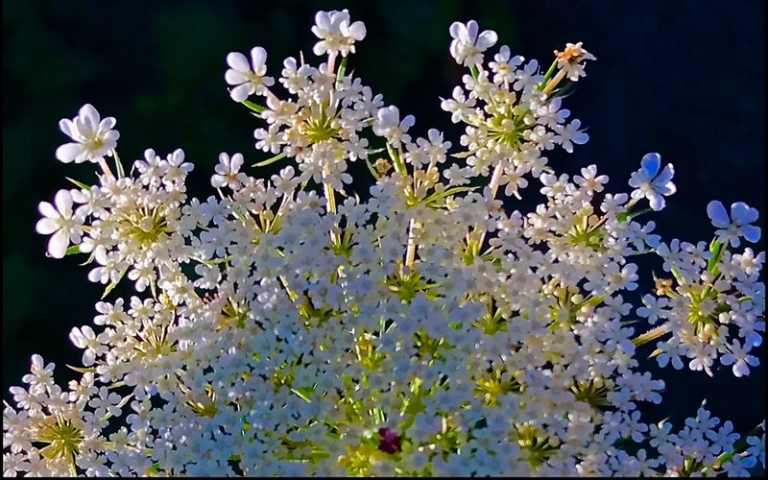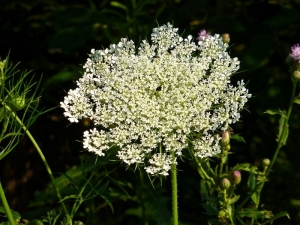
A common West Virginia wildflower, though not an American native, Queen Anne’s Lace appears to have traveled ahead of European settlers as they arrived in the region.
Belonging to the carrot family, Daucus carota is native to temperate regions of Europe and southwest Asia and is naturalized to North America and Australia. It's a biennial also known as wild carrot. It can grow tall—about three to four feet high.

Its flower, a flat-topped white umbel, resembles lace and often has a solitary purplish or black dot at its center. The flowers bloom from late spring until mid-autumn. Each flower cluster is made up of numerous tiny white flowers. The flower cluster starts out curled up and opens to allow pollination. The cluster then rolls itself shut again as it goes to seed at the end of the season.
Its feathery leaves, which somewhat resembled fern-like foliage, resemble those of the domestic carrot. The bases of leafstalks are broad and flat.
It’s important to note that Queen Anne’s lace leaves also closely resemble the leaves of poison hemlock, fool’s parsley, and water hemlocks—all poisonous cousins of Queen Anne’s lace. Roots are long, pale, and woody and are finger-thin, and, when broken or bruised, are small like carrots.
Legend has it that Queen Anne, the wife of King James I of England (1665-1714), was challenged by her friends to create lace as beautiful as a flower. While making the lace, she pricked her finger, and it’s said that the purple-black flower in the center of Queen Anne’s Lace represents a drop of her blood.
Queen Anne’s Lace contains vitamins K, B, and C and pectin, lecithin, glutamine, phosphatide, and cartodin.
Early Europeans cultivated Queen Anne’s lace, and the Romans ate it as a vegetable. The roots can also be dried, roasted, and ground and used as a coffee substitute in a manner similar to chicory.
The young leaves can be eaten in a green salad or tossed in bits into soups as a spice. The flower heads can be dipped in batter and fried as fritters. American colonists boiled the taproots, sometimes in wine as a treat.
Interestingly, Queen Anne’s lace is high in sugar—second only to the beet among root vegetables in terms of sugar content. Irish emigrants would use it to sweeten puddings and other foods in the early days in Appalachia.
During the Victorian Era, Queen Anne’s Lace was commonly sold and used in flower arrangements.
Chervil and Queen Anne’s lace, when made into an infusion, can be used in the treatment of water retention, stomach upset, and skin problems. It can be used to promote wound healing and as a mosquito repellent when applied to the skin.
In faery lore, the flower could be used as a bassinet for the very young fae. When the flower cluster is young, the flower makes a basket or nest shape to hold a young fae. As the faery matures, the flower open to its typical flat-topped flower shape.
If you mow down the young Queen Anne’s lace flower clusters during their nesting stage, this can anger the fae, which may cause them to be more mischievous. This can lead to the misplacing of commonly used items, such as keys, tools, and cell phones. If you let the flower reach maturity and the young fae full development, the troublesome misplacement of items lessens.




























